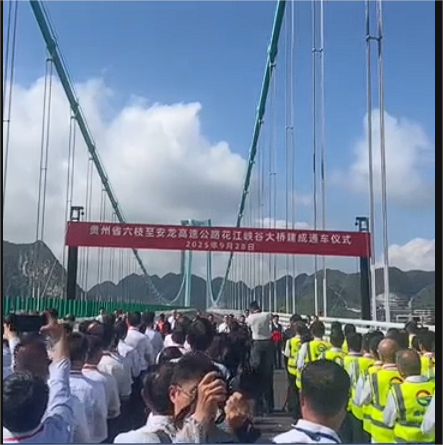World’s tallest bridge opens in Guizhou, marking another milestone in China’s infrastructure building

The Huajiang Grand Canyon Bridge, the world’s tallest bridge, officially opened to traffic on Sunday morning in Southwest China’s Guizhou Province, marking another monumental achievement in Guizhou’s world-leading bridge-building legacy and China’s robust infrastructure expansion.
On Sunday morning, local officials and residents from different ethnic groups gathered on and around the new Huajiang Grand Canyon Bridge for a grand ceremony, celebrating a proud moment as the bridge is poised to significantly boost local economic and social development while setting a new global benchmark for bridge-building.
With a vertical height of 625 meters – roughly twice the height of the Eiffel Tower, the Huajiang Grand Canyon Bridge is now the tallest bridge in the world. The 2,890-meter bridge, with a span of 1,420 meters, is also the world’s largest span bridge to be built in a mountainous area, according to the Xinhua News Agency.
Beyond its sheer size, the Huajiang Grand Canyon Bridge stands as an engineering masterpiece. Construction began in 2022, and the bridge achieved multiple technological breakthroughs in wind-resistant design, high-altitude construction, and other critical areas.
The bridge innovatively employs advanced technologies such as an intelligent cable hoisting system and 2,000 MPa high-strength steel wire, securing 21 authorized patents, according to Guizhou officials.
These achievements bring tangible benefits to residents in this remote region, who have long faced difficult transportation conditions.
Spanning the border between Qianxinan Buyi and Miao Autonomous Prefecture and Anshun City in Guizhou, the Huajiang Grand Canyon Bridge has reduced travel time between the two banks from two hours to two minutes, significantly improving regional connectivity and spurring economic and social development.

Amid the festive buzz of the Huajiang Grand Canyon Bridge’s official opening to traffic, Lu Qiong, a resident of the Buyi ethnic group in Guizhou, made a special effort to don her elaborate traditional costume. She arrived at the bridge early, eager to witness this historic moment for her hometown firsthand.
“I feel extremely excited to witness this super project take root in my hometown. It has made our travel much more convenient and will bring more tourists to Guizhou to learn about this beautiful land,” Lu told the Global Times on Sunday at the Yundu Service Area overlooking the bridge.
Her family shares a close bond with this bridge. At the Yundu Service Area, they run a snack shop that specializes in Buyi-style specialty foods.
They are looking forward to seizing the opportunity of the bridge’s opening to share the authentic flavors of their hometown and the rich Buyi ethnic customs with travelers passing through.
Lu’s excitement is shared by many local residents in the region.
“For our village, the opening of the bridge brings huge actual benefits,” Liang Shaoyu, the former head of Huajiang Village, which is located right below the bridge, told the Global Times.
In an interview, Liang, a villager in his 70s, recalled the challenging times when locals relied on bamboo boats, later a lime-built bridge, and eventually a steel chain bridge to cross the Huajiang River.
“From the age of eight, I witnessed firsthand the harsh conditions in our village,” Liang said. Now with better roads, come greater opportunities. As the bridge draws many fans from across the nation, it also brings many business opportunities for Huajiang Village, where many old homes have been turned into modern homestays amid a tourism boom, according to Liang.
In Guizhou, an innovative business model blending transportation and tourism is emerging. This is evident at the Huajiang Grand Canyon Bridge, where tourism facilities and services, including a café perched 800 meters atop the bridge tower and a helicopter sightseeing service in nearby Huajiang Township, have been introduced.
“My favorite view is that of construction workers going up and down on the cables and standing on the cables to work,” Xie Chaoqing, a local resident who, over the past three years, used drones to document the construction process and livestreamed it to fans across the country, told the Global Times. “It shows how great our workers are. China’s infrastructure is indeed very impressive. And it is also a microcosm of our country’s growing power.”
China has emerged as the global leading power in infrastructure building, and Guizhou, in particular, has become known globally for its world-class bridges. To date, this mountainous province has more than 32,000 bridges built or under construction. Among the top 100 highest bridges in the world, Guizhou has taken nearly half of the seats, and the top three are all located in the province, according to official data.
“When some foreign journalists came to visit, they wondered why a bridge was built in this place. Their countries probably wouldn’t build bridges in such places because their capital wouldn’t allow them to. Only in China, our national conditions affirm the superiority of [socialism with Chinese characteristics] and our commitment to bringing prosperity to all our people, especially those in our less developed western provinces, so they can have a better life,” Liu Hao, chief project engineer of the Huajiang Grand Canyon Bridge at Guizhou Communications Construction Group, told the Global Times.
To further improve its transport network, China has continued to make massive investments in infrastructure during the 14th Five-Year Plan period (2021-25).
China has built the world’s largest highway network, with a total highway mileage of 191,000 kilometers, covering 99 percent of cities with a population of more than 200,000, Minister of Transport Liu Wei said during a press conference on July 21.
DISCLAIMER: The Views, Comments, Opinions, Contributions and Statements made by Readers and Contributors on this platform do not necessarily represent the views or policy of Multimedia Group Limited.
DISCLAIMER: The Views, Comments, Opinions, Contributions and Statements made by Readers and Contributors on this platform do not necessarily represent the views or policy of Multimedia Group Limited.
Source link




